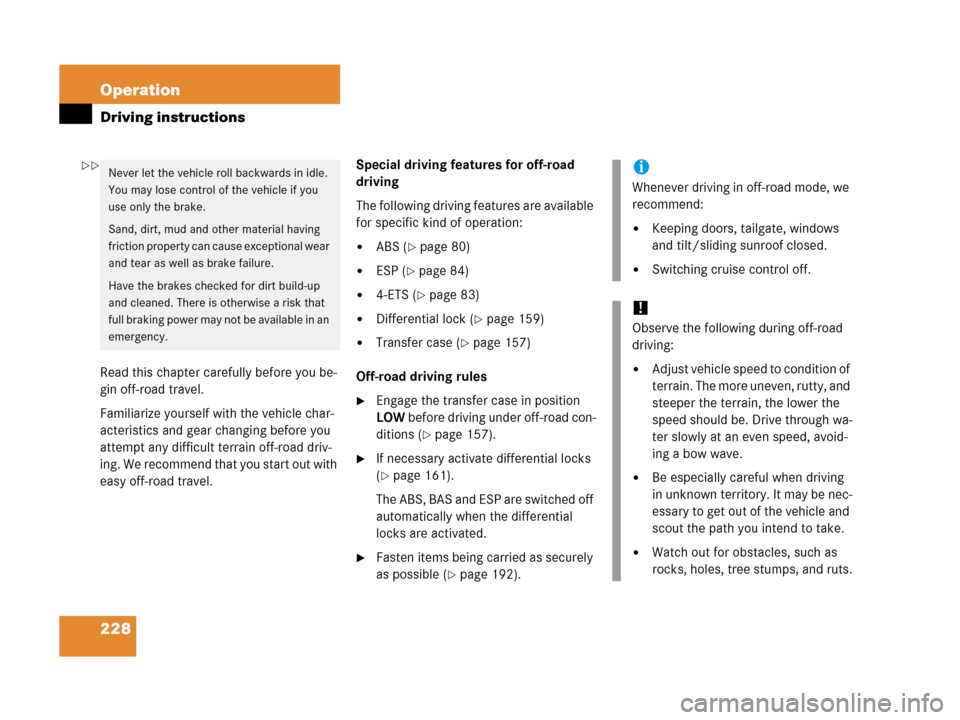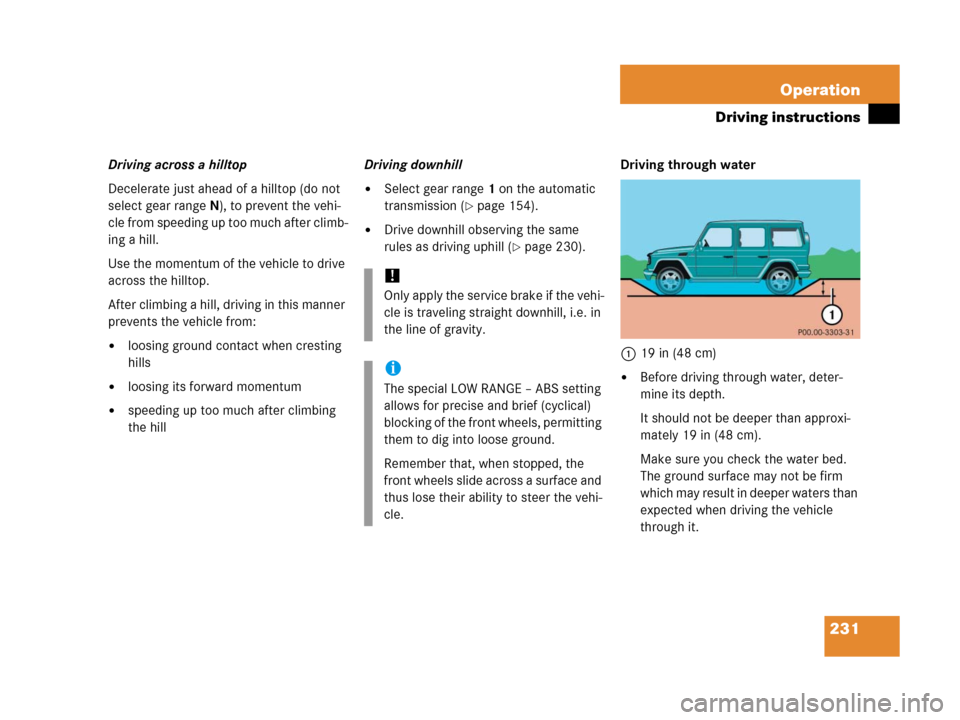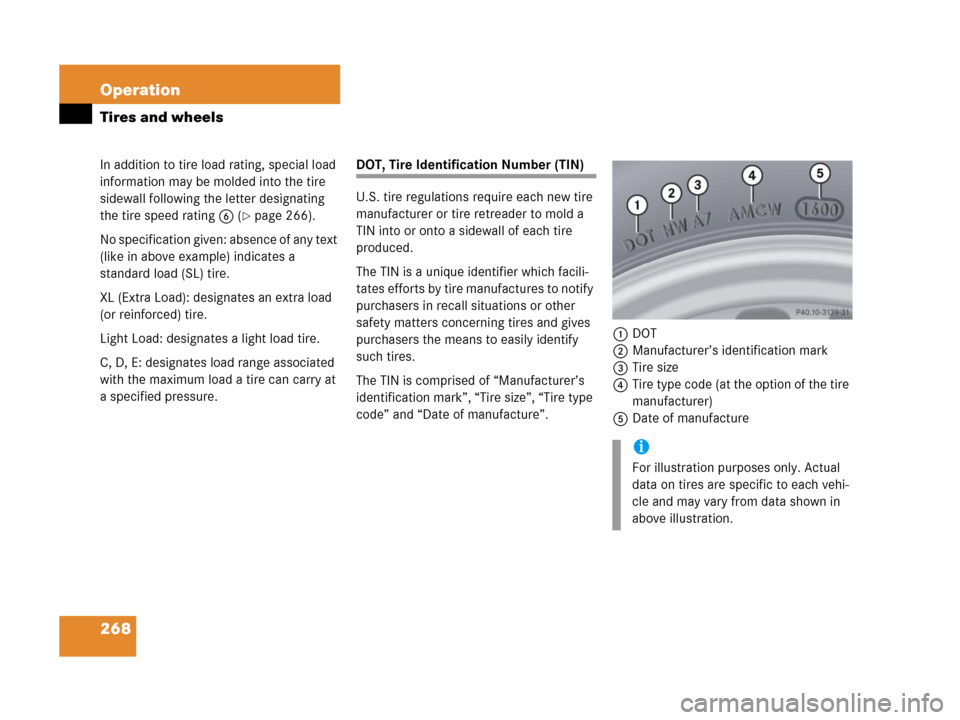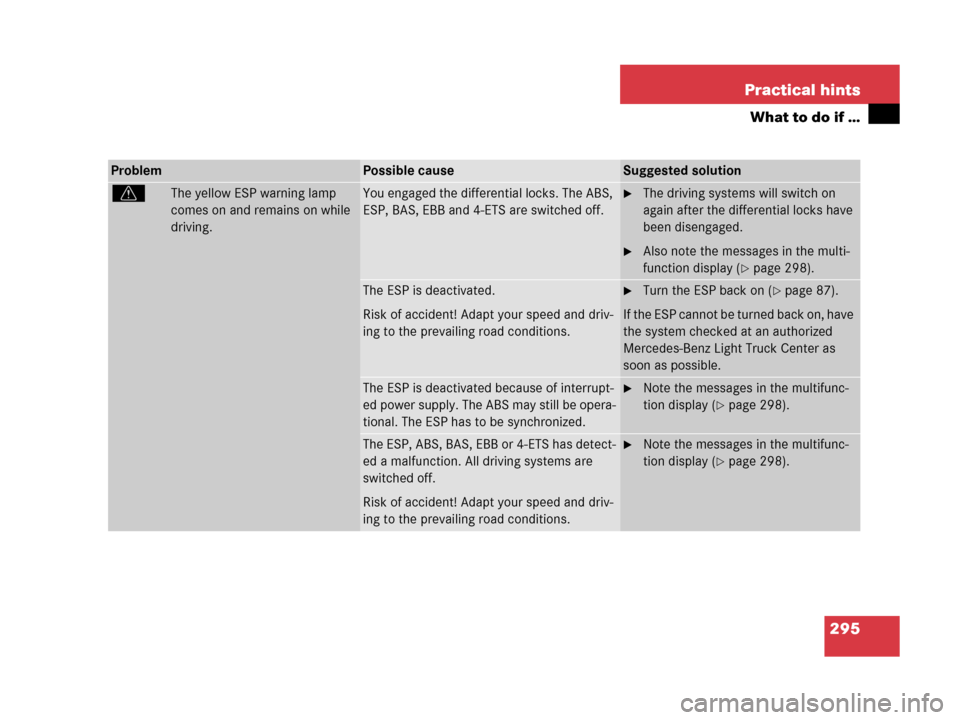Page 229 of 417

228 Operation
Driving instructions
Read this chapter carefully before you be-
gin off-road travel.
Familiarize yourself with the vehicle char-
acteristics and gear changing before you
attempt any difficult terrain off-road driv-
ing. We recommend that you start out with
easy off-road travel.Special driving features for off-road
driving
The following driving features are available
for specific kind of operation:
�ABS (�page 80)
�ESP (�page 84)
�4-ETS (�page 83)
�Differential lock (�page 159)
�Transfer case (�page 157)
Off-road driving rules
�Engage the transfer case in position
LOW before driving under off-road con-
ditions (
�page 157).
�If necessary activate differential locks
(
�page 161).
The ABS, BAS and ESP are switched off
automatically when the differential
locks are activated.
�Fasten items being carried as securely
as possible (
�page 192).
Never let the vehicle roll backwards in idle.
You may lose control of the vehicle if you
use only the brake.
Sand, dirt, mud and other material having
friction property can cause exceptional wear
and tear as well as brake failure.
Have the brakes checked for dirt build-up
and cleaned. There is otherwise a risk that
full braking power may not be available in an
emergency.i
Whenever driving in off-road mode, we
recommend:
�Keeping doors, tailgate, windows
and tilt/sliding sunroof closed.
�Switching cruise control off.
!
Observe the following during off-road
driving:
�Adjust vehicle speed to condition of
terrain. The more uneven, rutty, and
steeper the terrain, the lower the
speed should be. Drive through wa-
ter slowly at an even speed, avoid-
ing a bow wave.
�Be especially careful when driving
in unknown territory. It may be nec-
essary to get out of the vehicle and
scout the path you intend to take.
�Watch out for obstacles, such as
rocks, holes, tree stumps, and ruts.
��
Page 232 of 417

231 Operation
Driving instructions
Driving across a hilltop
Decelerate just ahead of a hilltop (do not
select gear rangeN), to prevent the vehi-
cle from speeding up too much after climb-
ing a hill.
Use the momentum of the vehicle to drive
across the hilltop.
After climbing a hill, driving in this manner
prevents the vehicle from:
�loosing ground contact when cresting
hills
�loosing its forward momentum
�speeding up too much after climbing
the hillDriving downhill
�Select gear range1 on the automatic
transmission (
�page 154).
�Drive downhill observing the same
rules as driving uphill (
�page 230).Driving through water
119 in (48 cm)
�Before driving through water, deter-
mine its depth.
It should not be deeper than approxi-
mately 19 in (48 cm).
Make sure you check the water bed.
The ground surface may not be firm
which may result in deeper waters than
expected when driving the vehicle
through it.
!
Only apply the service brake if the vehi-
cle is traveling straight downhill, i.e. in
the line of gravity.
i
The special LOW RANGE – ABS setting
allows for precise and brief (cyclical)
blocking of the front wheels, permitting
them to dig into loose ground.
Remember that, when stopped, the
front wheels slide across a surface and
thus lose their ability to steer the vehi-
cle.
Page 269 of 417

268 Operation
Tires and wheels
In addition to tire load rating, special load
information may be molded into the tire
sidewall following the letter designating
the tire speed rating6 (
�page 266).
No specification given: absence of any text
(like in above example) indicates a
standard load (SL) tire.
XL (Extra Load): designates an extra load
(or reinforced) tire.
Light Load: designates a light load tire.
C, D, E: designates load range associated
with the maximum load a tire can carry at
a specified pressure.
DOT, Tire Identification Number (TIN)
U.S. tire regulations require each new tire
manufacturer or tire retreader to mold a
TIN into or onto a sidewall of each tire
produced.
The TIN is a unique identifier which facili-
tates efforts by tire manufactures to notify
purchasers in recall situations or other
safety matters concerning tires and gives
purchasers the means to easily identify
such tires.
The TIN is comprised of “Manufacturer’s
identification mark”, “Tire size”, “Tire type
code” and “Date of manufacture”.1DOT
2Manufacturer’s identification mark
3Tire size
4Tire type code (at the option of the tire
manufacturer)
5Date of manufacture
i
For illustration purposes only. Actual
data on tires are specific to each vehi-
cle and may vary from data shown in
above illustration.
Page 279 of 417

278 Operation
Winter driving
Before the onset of winter, have your
vehicle winterized at an authorized
Mercedes-Benz Light Truck Center. This
service includes:
�Check of anticorrosion and antifreeze
concentration.
�Addition of cleaning concentrate to the
water of the windshield and headlamp
cleaning system. Add MB Concentrate
“S” to a premixed windshield washer
solvent/antifreeze which is formulated
for below freezing temperatures
(
�page 382).
�Battery test. Battery capacity drops
with decreasing ambient temperature.
A well charged battery helps to make
sure that the engine can be started,
even at low ambient temperatures.
�Tire change. Mercedes-Benz recom-
mends M+S rated radial-ply tires with a
minimum tread depth of approximately
1/6in (4 mm) on all four wheels for the
winter season.
Winter tires
Always use winter tires at temperatures
below 45°F (7°C) and whenever wintry
road conditions prevail. Not all M+S rated
tires provide special winter performance.
Make sure the tires you use show M+S and
the mountain/snowflake.marking on
the tire sidewall. These tires meet specific
snow traction performance requirements
of the Rubber Manufacturers Association
(RMA) and the Rubber Association of Can-
ada (RAC) and have been designed specif-
ically for use in snow conditions. Using
winter tires is the only way to achieve the
maximum effectiveness of the ABS and
ESP in winter operation.For safe handling, make sure that all
mounted winter tires are of the same make
and have the same tread design.
Always observe the speed rating of the
winter tires installed on your vehicle. If the
maximum speed for which your tires are
rated is below the speed rating of your
vehicle, you must place a notice to this
effect where it will be seen by the driver.
Such notices are available from your tire
dealer or from any authorized
Mercedes-Benz Light Truck Center.
Warning!G
Winter tires with a tread depth under 1/6in
(4 mm) must be replaced. They are no
longer suitable for winter operation.
Page 291 of 417

290 Practical hints
What to do if …
Lamps in instrument clusterGeneral information:
If any of the following lamps in the instru-
ment cluster fails to come on during thebulb self-check when switching on ignition,
have the respective bulb checked and re-
placed if necessary.
ProblemPossible causeSuggested solution
-The yellow ABS indicator lamp
comes on while driving.You engaged the differential locks. The ABS,
ESP, BAS, EBB and 4-ETS are switched off. �The driving systems will switch on
again after the differential locks have
been disengaged.
The ABS has detected a malfunction and has
switched off. The ESP, BAS, EBB and 4-ETS
are also switched off (see messages in dis-
play).
If the ABS control unit is malfunctioning, oth-
er systems such as the navigation system or
Rear Parking Assist* may also malfunction.
The brake system is still functioning normally
but without the ABS available.�Continue driving with added caution.
Wheels will lock during hard braking
reducing steering capability.
�Read and observe messages in the
multifunction display (
�page 300).
�Have the system checked at an autho-
rized Mercedes-Benz Light Truck
Center as soon as possible.
Failure to follow these instructions in-
creases the risk of an accident.
Page 292 of 417
291 Practical hints
What to do if …
ProblemPossible causeSuggested solution
-The yellow ABS indicator lamp
comes on while driving.The ABS has switched off because charging
voltage has fallen below 10 volts. The battery
may not be charged.�Turn off unnecessary electric con-
sumers.
When the battery voltage is above this
value again, the ABS is operational
again.
�Note the messages in the multifunc-
tion display (
�page 298).
Page 294 of 417
293 Practical hints
What to do if …
ProblemPossible causeSuggested solution
;(USA only)
3 (Canada only)
-The red brake warning lamp and
the yellow ABS indicator lamp
come on when the engine is run-
ning and you hear a warning
sound for approximately five sec-
onds.
The EBB has detected a malfunction and has
s w i t c h e d o f f . Y o u s h o u l d b e p r e p a r e d f o r y o u r
vehicle to perform differently than normal
when braking. �Continue driving with added caution.
�Have the system checked at an autho-
rized Mercedes-Benz Light Truck
Center as soon as possible.
�Also note the messages in the multi-
function display (
�page 298).
Failure to follow these instructions in-
creases the risk of accidents.
Page 296 of 417

295 Practical hints
What to do if …
ProblemPossible causeSuggested solution
vThe yellow ESP warning lamp
comes on and remains on while
driving.You engaged the differential locks. The ABS,
ESP, BAS, EBB and 4-ETS are switched off. �The driving systems will switch on
again after the differential locks have
been disengaged.
�Also note the messages in the multi-
function display (
�page 298).
The ESP is deactivated.
Risk of accident! Adapt your speed and driv-
ing to the prevailing road conditions.�Turn the ESP back on (�page 87).
If the ESP cannot be turned back on, have
the system checked at an authorized
Mercedes-Benz Light Truck Center as
soon as possible.
The ESP is deactivated because of interrupt-
ed power supply. The ABS may still be opera-
tional. The ESP has to be synchronized.�Note the messages in the multifunc-
tion display (
�page 298).
The ESP, ABS, BAS, EBB or 4-ETS has detect-
ed a malfunction. All driving systems are
switched off.
Risk of accident! Adapt your speed and driv-
ing to the prevailing road conditions.�Note the messages in the multifunc-
tion display (
�page 298).